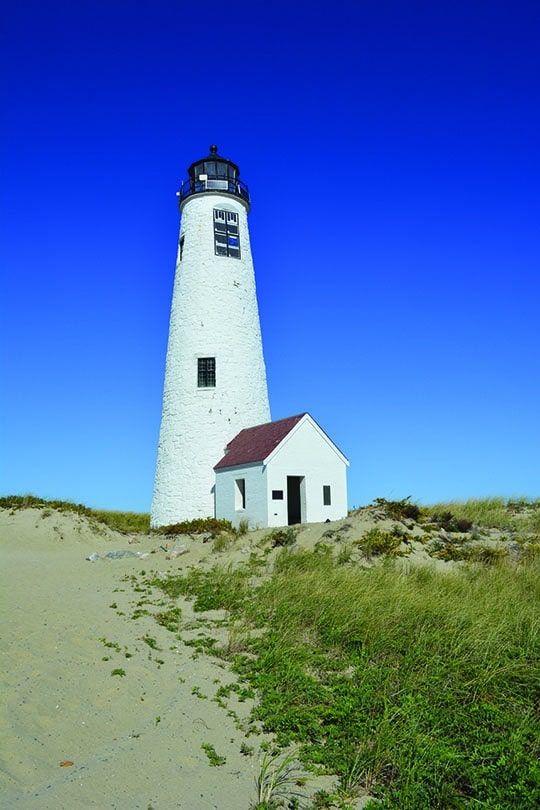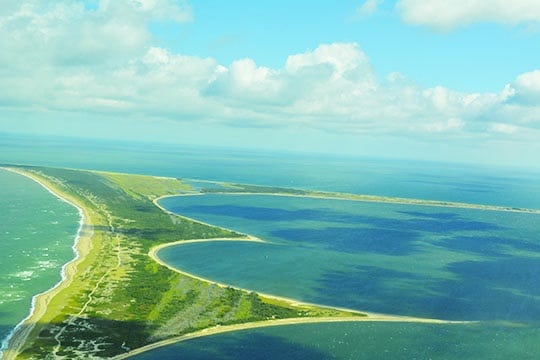
Take a ride on Nantucket’s wildside
Cape Cod Life / September/October 2016 / Nature, Recreation & Activities
Writer: Matthew J. Gill / Photographer: Jennifer Dow
Take a ride on Nantucket’s wildside

Cape Cod Life / September/October 2016 / Nature, Recreation & Activities
Writer: Matthew J. Gill / Photographer: Jennifer Dow
A bumpy beach road leads visitors to the stunning Coskata-Coatue Wildlife Refuge.

photograph by Jennifer Dow
Drivers attempting to make their way out to the Coskata-Coatue Wildlife Refuge and Great Point Light on the northern tip of Nantucket are well advised to follow protocol should they wish to make theirs a return trip. At the Wauwinet Gatehouse, just south of The Wauwinet resort, drivers are instructed to deflate the tires of their vehicles to 12 to 15 pounds per square inch before proceeding further; one might call this Nantucket’s deflate-gate.
It is also recommended that only those in four-wheel drive or all-wheel drive vehicles attempt the journey, and a high clearance between frame and ground is a must. Edging forward, leaving Wauwinet Road behind for the unpaved sandy-ness beyond, a sign states “Caution: Extremely soft sand.” Another commands, “Deflate now.” In short order, one understands the concern.
With Fred Pollnac of the Trustees of Reservations behind the wheel of a truck made for the cause, the vehicle bounces up and down while our contingent proceeds slowly along the road, a continuous wave of small-but-steep hills and deep-sanded valleys. If you think the driving was tough, imagine the note taking!
Why go through all this trouble for some simple sightseeing? Pollnac, a relative newcomer to Nantucket, explains. “I think this is one of the most unique and best preserved beach habitats in the New England area,” he says. “It is just a fantastic place. The public that comes here really appreciates the property.” He adds that visitors who come to Nantucket a lot, and really know the island, claim the refuge is the best part of the island. And when it comes to driving through the sand in an attractive—albeit remote—coastal landscape, Pollnac focuses less on the bumps, more on the recreational benefits. “There aren’t that many places in the United States where you can do this,” he says. “People get a kick out of it.”

Photograph by Jennifer Dow
The distance from the Wauwinet Gatehouse to Great Point Light, Nantucket’s northernmost point, is about five miles. Headed north, with the Atlantic to the east and Nantucket Harbor to the west, one first comes to an area known as The Haulover. Here, from the early 1800s to the mid 1900s, the fishermen of Nantucket would often haul their boats over this thin stretch of land between the water bodies to save the time and energy it would take them to sail out of the harbor, north around Great Point, and east to the fishing grounds.
A short distance further, we reach the Coskata-Coatue Wildlife Refuge. The Trustees owns and oversees the 1,117-acre preserve, which features a diversity of geographical features and habitats, from beach and woodland to salt marsh and pond. Each of the different areas has a name based on its characteristics.
We soon arrive at Coskata Woods, a rugged area that is somewhat sheltered between dune and harbor and pond. Some of the trees are 200 or more years old. “I’ve seen a lot of oak trees in my day,” says Pollnac—who studied wildlife biology, and earned his PhD in ecology and environmental science—“and these are unlike any I’ve ever seen. It’s just an amazing place.”
Driving another mile north, we pass by wetlands called The Glades and another wooded area, The Cedars. We come to a fork in the trail. Were we to travel southwest for a few miles, we would enter the Coatue Wildlife Refuge, a thin and curving peninsula that is owned by the Nantucket Conservation Foundation and features one of the most striking geological features on the island: a set of sharp land points that from above look like thorns, or teeth, or a serrated smile. The peninsula is a barrier beach that protects the Island’s eastern half, and visitors in appropriate vehicles can drive along a trail for six miles all the way to Coatue Point—and the entrance to Nantucket Harbor.
We did not take this route, though; we continued north from the fork, and the peninsula narrowed before us to a thin, one-mile pencil of dune and beach. This area is known as The Galls. There’s a sandy parking lot here, and the area is popular for sunbathing and fishing—and for viewing seals. Walking along the beach, we noticed a few seals in the water just off shore, peering curiously back at us. One visitor counted 300 seal sightings in a single day last June; Pollnac also witnessed a seal eating a crab, which to him was a first.
The entire wildlife refuge is a mecca for birds (and birdwatchers), and The Galls’ beaches are a popular nesting area for piping plovers. At certain times during the year, the Trustees limit some of the vehicle trails, and lower the speed limit, in consideration of the birds. “We do try to protect them while they’re here so they can survive and propagate the species,” Pollnac says.

Photograph by Jennifer Dow
He adds that the Trustees’ shorebird manager has a challenging task: he or she is charged with spotting and identifying all of the piping plovers, whose nests are tiny and camouflaged in the sand. The Trustees’ staff uses binoculars or spotting scopes to spy the birds, and in 2015 they observed and tracked eight nesting pairs. “When I saw my first one I was pretty excited,” Pollnac says.
As this is a wildlife refuge, plovers and seals aren’t the only ones around. In different areas of Coskata and Coatue, one can view red-tailed hawks, northern harriers, osprey, great blue herons, egrets, kestrel, terns, buzzards, peregrine falcons, and occasionally a jaeger. On the ground below are deer, rabbits, and milk snakes as well as mice, rats, and feral cats. There are lots of insects, too, particularly in sheltered areas with less wind. “The mosquitos can be fierce,” Pollnac says, especially in August. Notably, the wildlife refuge—like all other areas of Nantucket—has no coyotes, skunks, possum, or raccoons; these animals have yet to find their way across the Sound.
Continuing for another mile, the peninsula widens again and we arrive at the stunning-in-white Great Point Light. Originally built in the late 1700s, the light has weathered many incidents over the years, including a massive fire in 1816. In 1984, a severe storm toppled the light, and thanks to $1 million in fundraising and help from the late Sen. Edward Kennedy, the structure was rebuilt—and in 1986, re-lit. In 1991 another storm washed over the area just south of the light, making Great Point for a brief period its own island.
Today, the U.S. Coast Guard owns the light, and the U.S. Fish & Wildlife Service owns the land it sits on. On the beach just north of the light hundreds of seals huddle together, looking out over Nantucket Sound in the direction of Monomoy and Chatham.
As we make our way back to the gatehouse, at average speeds of 10 to 15 mph, Pollnac reflected on what makes this area so special. “It has a quality that is unlike any place you’ve ever been,” he says—and he adds that many people have expressed to him the same sentiment. “It’s full sensory immersion. You can experience wind, sun, nature, wildlife—everything.”
Generally, most visitors drive to the refuge—especially if they’re headed to Great Point—and 4×4 vehicles can be rented at various locations on the island.
From Memorial Day to Columbus Day a visitor’s fee is charged for access to the property; seasonal passes cost $160, and day passes are $65 with a personal vehicle, $35 with a rented vehicle. The Trustees also lead tours in summer in four-wheel drive vans. Pollnac says some visitors do arrive via kayak, or on foot. “It’s a challenging walk but some people do it.”
Regardless of how visitors get there, the Trustees recommend a stay of at least three hours and that visitors come well equipped with food, water, and the knowledge that there are no bathrooms on the refuge—only porta potties Memorial Day through Columbus Day. “We really want people to get out and see properties like this,” Pollnac says. “It’s a wonderful place to be.”
Curious? Here’s a final reminder about making the adventure in the appropriate vehicle, and to deflate the tires to the correct measurements. Pollnac says it’s not uncommon for the Trustees to field calls from drivers whose vehicles have gotten stuck in the sand. In fact, during the summer he says it can happen up to 10 times per day.
The Coskata-Coatue Wildlife Refuge is open daily, year-round. The Trustees of Reservations’ Nantucket office is at 44 Wauwinet Road. For more information, call 508-228-5646, or visit thetrustees.org.
Matthew Gill is the editor of Cape Cod LIFE magazine.



